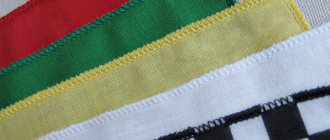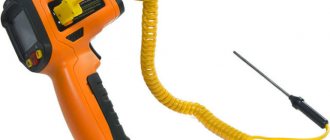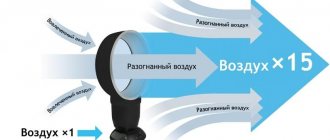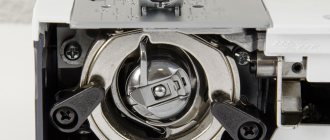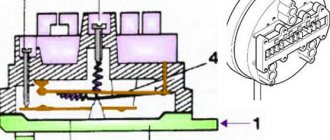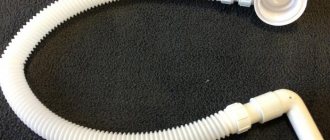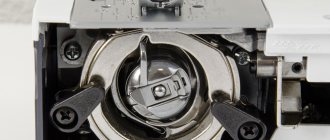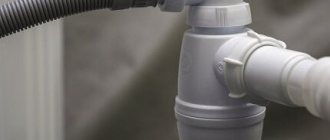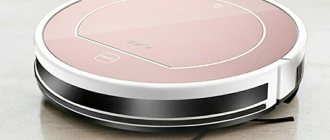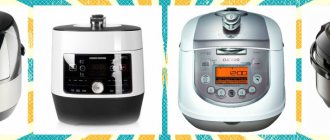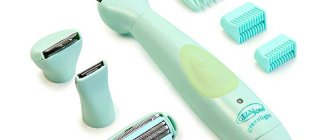Overlock is a special type of sewing equipment. An overlock stitch is necessary to finish the edge of the bulk material. As a result, the product takes on a finished appearance and looks neat. The device can also grind individual elements and decorate them. In industry, expensive multifunctional overlockers are used. At home, they use simpler equipment that can be purchased at an affordable price.
What is the difference between an overlocker and a sewing machine?
A sewing machine uses two threads to form stitches, which are intertwined with a shuttle to form a stitch. Overlock differs in that the process of its operation involves not 2, but a much larger number of threads (up to 10). Models with 4 threads are in greatest demand.
An overlock stitch made with an overlocker is elastic and strong. During the process, the edge of the material is simultaneously trimmed. There is also a combined type of equipment called a carpetlock. The device is a sewing machine with overlock functions and is used more often in professional sewing.
How an overlocker works and works
Overlockers are designed differently and differ in the scope of functions performed and other parameters. In particular:
- number of threads used;
- method of threading (it can be manual or automatic);
- thread tension adjustment system;
- type of knives;
- stitch options;
- stitch size;
- presser foot pressure.
The most advanced equipment is equipped with an electronic scoreboard and touch controls. On inexpensive devices, adjustment is usually done manually. Before you start working on the overlocker, it is threaded with the selected threads, and then the desired mode is set. Only after this does the overlaying itself occur. The needle stitches the fabric while simultaneously overcasting the edge.
Excess material is cut off and placed in a special tray. The fabric is drawn using a conveyor. To work with delicate types of material, you will need a removable converter. An overlocker is necessary when working with knitwear, delicate and elastic fabrics.
Adjusting thread tension
A high-quality, professional seam can only be achieved by correctly adjusting the thread tension. The degree of tension depends on the fabric and is selected almost individually (for the same type of fabric with equal thickness, texture and density, the same settings can be used).
Thread tension regulators on the Brother 1034 overlocker
In order not to waste time every time, you can make notes about the parameters in the user manual; some craftswomen even attach fabric samples.
If the instructions do not have a section for notes or are completely lost, you can find them online and print them with the required number of sheets for notes.
How to make an overlock stitch
Classic overlock stitching on an overlocker is performed using 3 or 4 threads. A three-thread stitch is performed in order to prevent the fibers of dense fabric from fraying along the edge.
- The optimal width of the overlock seam in this case is 4-6 mm. It is important to ensure that the thread tension is correct so that it does not become loose.
- The threads must be intertwined strictly at the cut, without shifting to the front or back side. On the front side, the needle thread forms even, smooth stitches; on the back side, barely noticeable dots remain on the fabric.
- The four-thread stitch is wider - up to 9 mm, its width depends on the overlocker model. A 4-thread overlock stitch leaves 2 parallel lines of needle thread and a looper thread crossing them on the right side, and 2 rows of small dots are formed on the wrong side of the fabric.
The seam should have a tight tension and weave along the edge of the fabric; due to the additional needle thread that fixes the stitches, this stitch is stronger.
Tips for sewing with an overlocker
Home → Machine sewing lessons → Overlock → Tips for sewing with an overlocker
Modern needlewomen strive for their items to be at least as good in quality as factory-made products. And some craftsmen manage to imitate branded items. Overlock in this case is the first assistant. And I am its active promoter. After all, sewing with this miracle machine is really pleasant and fast.
In my courses and trainings, I teach only advanced universal technology for processing products. It is both simple and fast. These are my preferences and the preferences of my students.
Therefore, for the impatient, here is a video in which I give five simple but important tips for sewing with an overlocker.
If you already use an overlocker, they will undoubtedly be useful to you. If you are just getting acquainted with a sewing machine called an overlock, you will see that sewing on it is very simple, and without any tricks.
As you know, sewing with an overlocker requires 3-4 spools of thread. It depends on what kind of seam you are going to make. If you sew a lot, then you don’t have problems with the number of threads. But in some cases, the first advice will be useful to you too.
Advice one
If you do not have the required number of threads of the same color, then set the most suitable color second from the right . Perform the stitching from the front side of the allowance.
Then the upper front part of the stitching will be the desired color, as you see in the photo below.
Tip two
For overcasting, use only three spools of thread. This will allow you to perform high-quality, non-rough overcasting stitches and save thread.
Tip three
Use the left needle for loose materials, and the right needle for thin materials . I don’t take out the needles, they don’t bother me. I just thread the right needle.
To set the desired seam width, you can use the additional seam width adjustment that is available in the overlocker (see the operating instructions for your overlocker)
Tip four
When adjusting thread tension in an overlocker, start by checking that the threads are correctly threaded in all thread guides and, most importantly, in the pressure plates. Once you are sure that the overlock threading is correct, you can begin adjusting the tension. At the same time, look carefully at how the adjusting screws are installed relative to the norm and each other.
For example, in my overlocker the normal tension is set to 4. But for one layer I have to slightly loosen the screw to 3.5
Tip five
Use all four threads and both needles to sew two pieces together. Then the seam will be stitching and overcasting. This seam is used to sew together parts of knitwear or loose garments.
And if you don’t have an overlocker yet, then pay attention to this model
This overlocker has a very reasonable price and an important factor is that you can buy good press feet for it on Ozone. One of these valuable paws sews on an elastic band. View more details...
Yes, and you can buy it on the Internet. Ozone transports goods all over Russia and is not very expensive.
If you have an overlocker, but you are still afraid to sew on it, sign up for the Knitting Boom-Apprentice training. I am sure that you will not only “make friends” with this magnificent machine, but also learn how to sew knitwear and make great progress in your sewing skills .
And I will be your personal mentor. Read REVIEWS
- Related Posts
- Finishing and sewing clothes with flat seams
- Hemming the bottom of the product with a hidden stitch on an overlocker
- Sewing on an overlocker. Stitching difficult cuts
- Creative overlock
- How to hem a flared skirt or oval-shaped piece
- About overlock, especially for those who don’t have one yet...
Discussion: 22 comments
- Valentina Anufrieva:
June 23, 2021 at 01:26 pmGood afternoon Have a nice weekend! No, I can't go out now, I'm working with this material.
- Natalya Roshchina:
November 25, 2021 at 03:43 pm
Finally closer to my overlock sewing gaps. But with your advice I’m already more confident! Thank you! I continue to master the Comfort 110 overlocker. I also purchased additional presser feet and am waiting for lessons
- EDWARD:
September 5, 2021 at 01:51
Good afternoon !
Taking into account your recommendations and correlating them with our capabilities, we bought a COMFORT model 550 overlocker. We don’t yet know how it differs from the 110, and we haven’t had time to gain experience working with it. Wait and see.
Sincerely, Galina and Eduard.
- Irina Voroshilova:
June 8, 2018 at 10:00 p.m.
Margarita, the brand of overlocker does not matter and there is no other foot for stitching parts. Make the narrowest seam and three threads. Read the article on the website Stitching complex cuts But do doll clothes need to be stitched? By the way, you can also read the article Sewing small parts from capricious materials
- Margarita:
June 8, 2018 at 15:40
Elna began to master overlocking. And I was faced with the fact that it is very inconvenient to sew small parts on it (clothes for dolls). Tell me if there are other feet to make it easier to turn the fabric. Or should I remove the knife?
- Dmitriy:
February 23, 2021 at 15:00
Good afternoon
My wife and I bought a Comfort 110 overlocker and a set of presser feet for it. This model is really good. The knife can be conveniently removed if necessary. I tried the foot for sewing in elastic. Cool!!! I recommend this overlocker.
- Elena:
February 5, 2021 at 07:03 pm
I have a Femeli carpet, but I wouldn’t refuse these paws.
- Irina Voroshilova:
January 30, 2021 at 01:01 pm
Tatyana, then you will be interested in the article “About overlocking, especially for those who do not have one.” And overlockers are now all made in China. Nobody is complaining.
- Tatiana:
January 30, 2021 at 12:57 pm
Thank you for the information. I am very interested in an overlocker for household needs at an affordable price. I wonder how reliable the Chinese overlocker is.
- Galina:
November 8, 2021 at 09:34
Thank you for the advice, not a single video/advice of yours remains unread)… I didn’t think that in retirement, between my grandchildren, I would be happy to learn a new business for me!)…
- Irina Voroshilova:
October 16, 2021 at 10:00
Tatyana, hello! All overlockers have, in principle, the same functionality. This one also has a double thread stitch, which is rare. I've never worked on it. I like it for the design and price. You won't find it cheaper. And if you also buy paws for it like here, look at the bottom of the page, then you couldn’t ask for anything better. The set consists of a needle threader and 4 Comfort overlocker feet
— Foot for blind stitching. The foot is used for sewing waistbands of knitwear and making invisible stitches on products.
- Gathering foot. The foot is used for sewing stepped skirts, frills, bodices, etc. The foot is also used for sewing two layers of fabric into a fold in one operation.
— Foot for sewing elastic. This foot is used for sewing in elastic.
— Foot for laying edging. Used for laying cord and edging between two pieces of material.
But this set may not be suitable for the five hundredth. And I am very sad that it does not suit my Brother.
- Tatiana:
October 16, 2021 at 02:15
Good afternoon I decided to buy an overlocker. They offer me Comfort 550. Do you think it’s worth taking an overlocker from this brand? It differs from model 110 in the number of seams, but sometimes too much is not good.
I was very interested in your advice and wanted to try it.
Thank you!
- Svetlana:
October 9, 2021 at 08:24 pm
Irina! Thank you for your such interesting and necessary advice. I just recently purchased an overlocker, and I didn’t understand at all why there was both a three-thread and a 4-thread one. Thanks to you, I will begin to master it consciously. THANK YOU!
- Tayana:
August 30, 2021 at 11:56 am
Thank you, Irina, this is exactly what I was looking for. I have the exact same overlocker. I will look for your videos.
- Irina Voroshilova:
August 23, 2021 at 10:41 pm
Tatyana, there are tips for Merilok, but in the Knitting Boom training - Apprentice+
- Tatiana:
August 23, 2021 at 10:36 pm
I would really like to get advice on working on Merilok carpet
- Tatiana:
July 22, 2021 at 6:12 pm
Thank you. Irina. I am very pleased to review all your lessons and admire you. Everything is so simple and useful. Thank you so much. I want to sew with you. With respect and delight, Tatyana
- Irina Voroshilova:
July 17, 2021 at 01:34 pm
Tatyana, hello! I just have Brother 3034d. When used skillfully, it works stably on a variety of materials in its price category. The letter "D" means an additional function, differential (compression, stretching of the edge during overcasting and stitching)
- Tatna:
July 17, 2021 at 10:21 am
Good afternoon Irina, tell us about the Brather 3034d overlocker. How is it when sewing thick and thin fabrics, is the tension stable? I’m thinking about buying it, but I’m still looking at 1034. Your answer will help me in choosing)
- Tatiana:
June 25, 2021 at 08:44 pm
Thank you. I didn’t know that for loose and thin fabrics you can use overcasting with right or left needles
- Tatiana:
June 21, 2021 at 12:58 pm
Thank you for sharing your invaluable experience and giving us the opportunity to quickly master and put into practice the capabilities of overlocking.
- Larisa Viktorovna:
June 20, 2021 at 07:58 pm
Thanks for the advice!
Add a comment Cancel reply
Purpose and technique of rolled seam
A rolled seam can also be done with a sewing machine, but an overlocker will perform it better. In translation, the name of this seam sounds like “twisted edge,” which speaks for itself. You have to use it when you need to finish the edge of the material with a simultaneous hem. The edge processed with a rolled seam looks like a stitch twisted inward.
It is in this technique that it is customary to sew frills of a skirt or dress together. The seam is used when creating concert costumes, as it simultaneously decorates the fabric. It is also used in sewing knitwear and processing tulle. To make a rolled seam, the stitch length is reduced to a minimum when adjusting, thereby changing the width of the stitch and promoting its curling. Other types of decorative stitches require more sophisticated equipment.
Tips for choosing seams
The overlock machine has all the capabilities to carry out work that allows maximum maneuverability when creating overcast stitches. When choosing a machine and stitch, keep the following in mind:
- If you buy an overlocker only to overcast edges, then you can limit yourself to a machine that allows you to work with two or three threads. And if you plan to make products with decorative stitches, then it is better to purchase an overlocker with a four-thread overlock.
- The presence of a differential feed option makes it possible to process elastic fabrics and produce assembly elements or flounces.
- Due to the fact that the width of the cut is adjustable, it is possible to make one seam in different versions.
Thanks to the variety of stitches produced by overlocking machines, you can implement any sewing idea and achieve a good result in your design solution. The main thing in this matter is to have a high-quality overlocker that satisfies all the needs of the seamstress.
To create high-quality and beautiful things, you need to have all the necessary equipment. A simple sewing machine will not be enough if you plan to create clothes and work with serious fabrics. Therefore, it is important to determine what an overlocker is, what it is needed for, and whether a beginner or an experienced seamstress can do without it.
Setting up an overlocker
Before adjusting the overlocker for a specific fabric, its operation is tested on a small piece of the selected material. You will need to set up your overlocker not only when changing from one type of fabric to another, but also when working with new threads. When creating one seam, the threads must be of the same thickness in order for the stitch to be uniform.
It is better to purchase high-quality consumables. Cheap threads often have knots and thickenings, which can lead to breakage. When setting up an overlocker, the main thing is to pay attention to adjusting the thread tension. This process is described in detail in the instructions for each equipment model.
First, the threads are loosened, and then the tension is gradually increased, starting the overlocker at a slow speed. For adjustments, it is better to use threads of contrasting colors in order to track which of them makes the stitching uneven and make additional adjustments.
The stitch length for most fabrics is kept within 2.5 mm. It is increased if heavy fabric is used for sewing. The distance from the game to the knife is selected individually, on average this value is 5 mm. It is necessary to regulate not only the thread tension, but also the feed speed of the fabric. On some models, you can further adjust the presser foot pressure using a screw.
Setting stitch length and width
To get a beautiful overlock stitch, you need to choose the right stitch length and width parameters. They are different for different materials.
Stitch length is the distance between needle punctures along the seam line. You can adjust the length of the overlock stitch by rotating a special lever. It is usually located on the right side of the case. The car manual tells you where it is and how to turn it.
The thicker the fabric, the larger the stitch size should be. For stitches of different sizes, different thread thicknesses are recommended:
| Fabric thickness | Types of fabric | Stitch size | Thread size |
| Thin cloth | cambric, chiffon, georgette, muslin | 2-3 mm | № 80-90 |
| Medium fabric | chintz, cloth, calico, poplin | 2.5-3.5 mm | № 60-80 |
| Tolstanya fabric | flannel, tweed, denim, satin | 3-4 mm | № 50-60 |
A stitch length of 2.5-3 mm is considered universal and is suitable for processing most fabrics.
Setting the stitch width is done by adjusting the cut width. This is the distance between the top knife and the left needle, or essentially the amount of fabric that remains inside the overlock stitch. This is done by turning a screw.
Narrow cutting widths are rarely used, mainly for thin fabrics, and require high thread tension, which can cause them to break.
Overlock for knitwear
If you often need to overlay knitwear, it is better to choose a model with a differential. In this case, it will be possible to make neat, unstretched seams, or, conversely, to ensure that the edge of the knitted item is wavy. On such an overlocker, the material can be intentionally gathered or, conversely, stretched while overcasting the edges. The function of differential feeding of fabric is ensured due to the uneven movement of the conveyor teeth. With this overlocker you can not only overcast seams, but also sew knitwear.
How does a Juki overlocker work?
- First, lift up the retractable thread guide.
- The threads are pulled through thread guides.
- Then there are the tension heads, in which the thread is pulled between two plates. This is where the thread tension is adjusted.
- The knife cuts off everything unnecessary from the product and evens out the cut.
- There are two loopers inside the overlocker: the top one is responsible for the front thread, the bottom one is for the purl thread.
- The wheels on the body are responsible for the stitch length.
- Manually turn the flywheel towards you.
- Using differential feed, you can make assemblies or, on the contrary, stretch the material.
- Often there is a lever on the body with which you can turn off the knife.
- On many overlocker models, the knife is raised manually inside the body.
- You can adjust the position of the knife using a wheel inside the body.
Understanding the overlock machine helps you thread it without problems. Never be afraid to read the instructions
